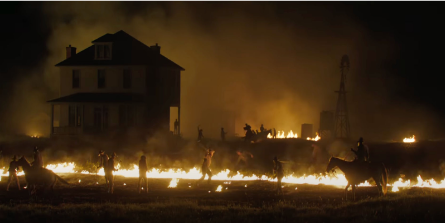“Killers of the Flower Moon,” was released on Oct. 20 in theaters. Based on the 2017 nonfiction book, the story follows the newly wealthy Osage tribe in 1920s Oklahoma that managed to strike gold with the discovery of massive oil reserves underneath their land. But what they got came with strings attached.
Shortly after the start of the film, the protagonist Ernest Burkheart (Leonardo Dicaprio) reads through an illustrated children’s book, the caption of one of the illustrations asks if the reader can see the wolves in the picture. It wasn’t just asking him, but it was asking the viewer as well.
While watching the movie, it’s obvious who the “wolves” are; William Hale and the community of settlers in Fairfax Oklahoma, the setting of it all.
Cattle baron William King Hale (Robert De Niro) orchestrates a series of carefully planned murders to wrestle the inheritance away from the Osage. He does this by manipulating his nephew Ernest, married to Osage heiress Mollie, into planning the killings in order for the oil money to go to her, and eventually him and Hale.
However, unlike the book, which mostly focuses on the investigation of said murders and how it created the FBI into what it is today, legendary director Martin Scorsese’s adaptation focuses much more on the human cost of greed, and the effect it has on the Osage and, more specifically, Mollie Burkheart’s psyche. The film portrays evil not as cackling villains, but as everyday people doing what they view as everyday things. Evil isn’t an abstract concept seen from news headlines and documentaries, but something the average joe participates in, either willingly or unwillingly.
The casting could not have been more perfect, with Dicaprio giving a masterful performance of a man who genuinely believes that he loves his significant other, yet is too short sighted to see what he’s doing to her. Robert De Niro gave a very Robert De Niro performance to further cement his legacy as one of the greatest performers to ever show up on the big screen. His portrayal of Hale might be one of the most despicable characters ever played by the actor. However, Lily Gladstone’s performance as Mollie Burkheart steals the spotlight. She does an immaculate job of portraying the most tragic character in the film and shows the emotional consequences of having a community get picked apart one by one.
From a director known for his crime movies and character studies of violent men, “Killers of the Flower Moon” manages to bring a fresh look to an age-old tale of greed. Scorsese uses this true story not only as a representation of events, but as a commentary on how the west was “won.” The legacy of settler colonialism is inescapable from the events of the film, and Scorsese directly challenges the viewer on how easy it is to play along to what’s happening.
Scorsese could not have picked a better time to release “Killers of the Flower Moon.” The film doesn’t just show the effects of greed and colonialism, but shows how it can’t be separated from modern day America. It’s the ultimate indictment of the “white savior” trope; instead of the FBI swooping in and saving the day, it shows how the murders left a hole in the Osage tribe that couldn’t be fixed by arresting a handful of those involved.
“Killers of the Flower Moon,” is the culmination of Scorsese’s 50+ year long career as a storyteller, one that time hasn’t spoiled, but instead aged like a fine wine.










